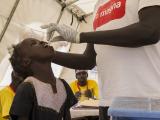Mar 7, 2013 (CIDRAP News) – A new study from the Centers for Disease Control and Prevention (CDC) says that resistance to two key antibiotics used to treat severe Salmonella infections is growing more common in the United States, although the prevalence in 2009 was still under 5%.
From 1996 through 2009, the share of tested Salmonella isolates resistant to ceftriaxone increased from 0.2% to 3.4%, while the proportion of isolates considered nonsusceptible to ciprofloxacin rose from 0.4% to 2.4%, according to the CDC report in Foodborne Pathogens and Disease.
On the other hand, the researchers found that the proportion of Salmonella isolates that were resistant to three or more antibiotics decreased from 17% to 9.6% over the same period. But they caution that the decrease was largely driven by a decline in multidrug resistance in one common serotype, Typhimurium.
Fluoroquinolone antibiotics, such as criprofloxacin, are often used as first-line treatment for adults with severe salmonellosis, while ceftriaxone is an important agent for children with similar cases, the report notes. The CDC estimates that nontyphoidal Salmonella sickens 1.2 million people in the United States annually, causing 23,000 hospitalizations and 450 deaths.
The testing was done as part of the National Antimicrobial Resistance Monitoring System (NARMS), a joint effort of the Food and Drug Administration (FDA), the US Department of Agriculture, the CDC, and state health departments. State labs receive human Salmonella isolates from clinical labs, and after serotyping the isolates, they pass some of them on to the CDC for antimicrobial susceptibility testing.
Over the 14 years of the study, 24,903 Salmonella isolates were tested, the report says. The most common serotypes were Typhimurium, at 21% of the total; Enteritidis, 19%; Newport, 9%; and Heidelberg, 5%.
The authors identified 730 isolates—2.9% of the 24,903—that were resistant to ceftriaxone. The most common serotypes were Newport, 45%; Typhimurium, 25%, and Heidelberg, 11%. As noted above, resistance rose from 0.2% to 3.4% over the study period, yielding an odds ratio (OR) of 20 and a 95% confidence interval (CI) of 6.3-64.
The team found that the increase in ceftriaxone resistance correlated with growth in resistance to ceftiofur, a closely related antibiotic that is used in some food animals in the United States. There were 737 (3.0%) isolates that showed resistance to ceftiofur.
For ciprofloxacin, the authors, using criteria from the Clinical and Laboratory Standards Institute, defined isolates with resistance or intermediate susceptibility as nonsusceptible to the drug. They found 40 isolates (0.2%) that were resistant, with Senftenberg, Typhimiurium, and Litchfield the most common serotypes. Another 442 isolates (1.8%) had intermediate susceptibility, led by Enteritidis, Typhimurium, and Virchow.
Combining the two groups, the team determined (as noted) that nonsusceptibility to Salmonella increased from 0.4% to 2.4% over the 14 years (OR, 8.3; 95% CI, 3.3-21).
As for multidrug resistance, the authors found 3,247 Salmonella isolates (13%) that were resistant to at least three classes of drugs. Multidrug resistance declined from 17% to 9.6% (OR, 0.6; 95% CI, 0.5-0.7).
Typhimurium accounted for 60% of the 85 serotypes represented and was the main driver of the decline in multidrug resistance, dropping from 50% in 1996 to 28% in 2009. For Salmonella Newport, the second most common serotype, multidrug resistance climbed from 5.9% in 1996 to a peak of 31% in 2001 before dropping to 8.4% in 2009. Heidelberg, in third place, increased from 12% in 1996 to 26% in 2009.
The authors comment that the increase in ciprofloxacin nonsusceptibility in Salmonella Enteritidis is notable, since that strain is rarely resistant to other drugs and is commonly associated with eggs.
The researchers say previous CDC research suggests that drug resistance in Salmonella "is predominantly a consequence of antimicrobial use in food animals." They briefly outline recent FDA steps to reduce the nontherapeutic use of antimicrobials in farm animals, and remark, "These and other approaches are needed to prevent the emergence and spread of resistant Salmonella in food animals and transmission to humans."
One potential limitation of the study, they note, is that if illnesses caused by resistant Salmonella tend to be more severe and more likely to lead to medical attention, they may have overestimated the percentage of resistant infections. "However, this could not have changed the direction of trends in resistance over time," they add.
Medalla F, Hoekstra RM, Whichard JM, et al. Increase in resistance to ceftriaxone and nonsusceptibility to ciprofloxacin and decrease in multidrug resistance among Salmonella strains, United States, 1996-2009. Foodborne Pathogens Dis 2013; 10(4) (Early online publication Mar 6) [Abstract]




















